 Brandinfo
Brandinfo

A number of high-profile tourism and ecotourism projects have transformed some of the country’s most famous tourism destinations. As a result, many local people, who previously struggled to make ends met, are also thriving.

|
Madam Dưỡng
The steady rise of Đà Nẵng
Twenty years ago, the Hàn River, which runs through the heart of Đà Nẵng, separated the rich from the poor. The city’s ramshackle neighbourhoods were clearly visible along the eastern riverbank, where Mrs. Lai runs her hugely popular Bánh Xèo Bà Dưỡng (Madam Dưỡng's Bánh Xèo). “In 1980s and 1990s, there was nothing much to do in Đà Nẵng. Even at the turn of the century, the greatest joy for many residents was to cross the bridge over the Hàn river. On weekends, some families would go for a picnic to the top of Ba Na Mountain by the some old ruined French villas, but I never went there. I was too busy trying to scrape a living,” said Mrs. Lai.
In those days, Đà Nẵng was a small city with a sleepy disposition. But since 2007, hundreds of infrastructure and urban development projects have been implemented in the city centre, giving the east side of the Hàn River a dynamic makeover. More recently, downtown Đà Nẵng — where tourists were rarely seen as they preferred to stay by the beach — has becoming a much livelier place. Nowadays, at Mrs. Lai’s restaurant, domestic and international tourists share tables and feast on specialities, such as bánh xèo and nem lụi.
“Many of them told us they were coming to see Ba Na Hills and to think I had never been! So in 2013, I decided to go for myself,” said Mrs. Lai, who was amazed when she arrived high up in the mountains. “I felt like I was stepping into paradise. I could not believe how beautiful it was with the replica French village and flower gardens.”
In 2018, Đà Nẵng welcomed 7.6 million tourist arrivals with more than 50 per cent travelling to Ba Na Hills, mostly by cable car. Since being unveiled to the world last year, the stunning Golden Bridge — already considered an iconic sight of Việt Nam — has become a must-see destination for foreign visitors to Đà Nẵng.
Now the whole of Đà Nẵng is booming thanks to this spike in tourism that has created jobs for thousands of local people, who have been able to lift their families and communities out of poverty.

|
Doan Minh Tuyen
A better life in Hạ Long city
Tourism has also been a boon for the city of Hạ Long. Having studied electromechanical engineering, Doan Minh Tuyen was unable to find work in his field of expertise. “I went to Hà Nội and worked as a taxi driver for 10 years, but I struggled to making a living,” said Tuyen, who decided to move back to his hometown in 2016. “The city had changed so much in that time. The streets were buzzing with tourists. I knew I could make a better living if I worked as a taxi driver in Hạ Long and it’s true. I am busy, all day and all evening. In less than two years, I have paid off the loan on my car and I earn a good monthly income, helping me to take care of my family.”
Tuyen often picks up guests near Sun World Halong Park, which has re-energised the area around Bãi Cháy (Cháy beach). Now every evening, the city centre is a wonderland of bright lights while a mix of international and domestic tourists roam the streets shopping and feasting on local specialities. Local food vendors are also thriving and making higher income than ever.
Just seven years ago, Hạ Long, which sits on the threshold of the world heritage Hạ Long Bay, was routinely overlooked. Tourists just passed through the city on the way to the bay. Many wouldn’t even stay one night in the city. But a number of high-profile tourism and infrastructure projects have transformed the city, making Hạ Long much more accessible and much more fun.
Now there are theme parks with thrilling rides, such as Typhoon Water Park and Dragon Theme Park, five star resorts, a newly opened modern airport and a brand new port exclusively for luxury cruisers, and much more besides. In 2018, a record 12.2 million visitors came to Quảng Ninh Province, generating VND24,000 billion in revenue, an increase of 28.1% year on year. It is expected that 2019 will post even higher stats, helping the city to prosper further.

|
Má A Tông's family
Far-reaching change in Sa Pa
When applying for the job of security officer at Sun World Fansipan Legend tourist complex, Ma A Tong and his family were burdened with a debt of over VND30 million. His wife had a little farm, but it was not big enough to feed their family. Tong borrowed VND7 million to pay tuition for a course on how to be a tour guide, but he was forced to abandon the course to help his family build a temporary shelter on the hillside. “Luckily I got a job at Sun World Fansipan Legend. If I hadn’t, I really don’t know what would have happened to us,” says Tong.
After just under three years of working at Sun World Fansipan Legend, Tong has paid off all his debts. Moreover, his employer supported him in building a new house and purchasing a new motorbike. Life is good for Tong and his family and for many others. Since the Fansipan cable car was put into operation in 2016, many ethnic minorities living around Sa Pa have benefited from the burgeoning tourism industry. According to Mr. Nguyen Xuan Chien, the director of Sun World Fansipan Legend, one third of the employees working in the tourism complex are local ethnic minority people, mainly coming from nearby H’Mong, Day and Thai communities.
Beside the eye-catching cable-car system, Sa Pa is now also home to the five-star Hotel de la Coupole Sapa - MGallery by Sofitel, a stunning creation designed by Bill Bensley under the investment of Sun Group that has set a new benchmark for luxury tourism in Sa Pa.
In 2018, the number of tourists coming to Lao Cai reached 4,246,590, an increase of 79 per cent compared to 2015, when the Fansipan Cable Car and Sun World Fansipan Legend were yet to open.
It’s clear to see how strategic investments in the tourism destination have made a significant contribution to transforming undeveloped landscapes into tourism paradises, providing jobs and generating income for local people and thereby improving the quality of life.